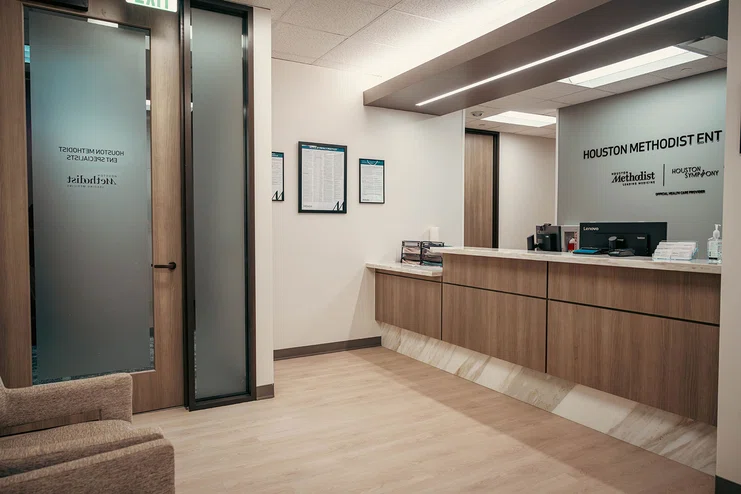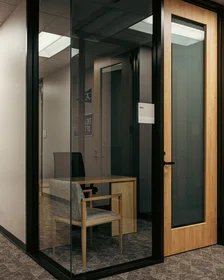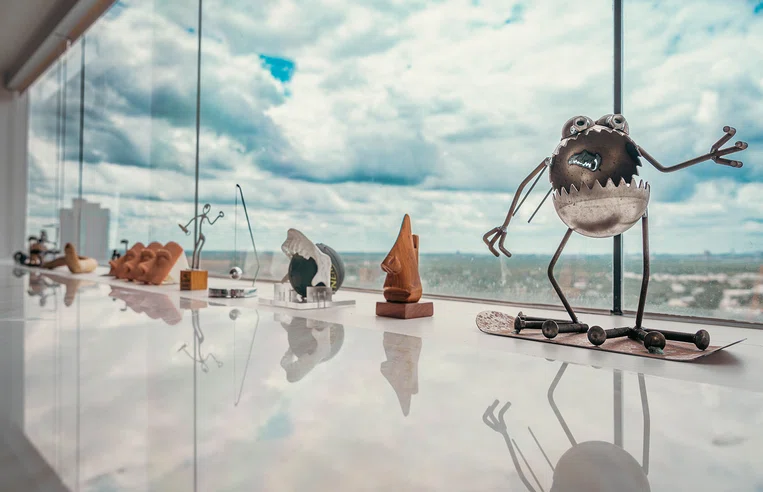

Archives
Otolaryngology – Head and Neck Surgery Gets New Face for the Future
The new face of the Department of Otolaryngology – Head and Neck Surgery at Smith Tower moves the team into the future with patient-centric clinic space on the 17th Floor and collaborative academic construction for research and education on the 20th Floor.
Patient services now take up the entire 17th Floor where two-thirds of the floor formerly was clinical, and the other third was offices. “Now we’re tearing out offices that were built just two years ago,” said Mas Takashima, MD, FACS, Sylvia and James E. Norton Distinguished New Century Chair, Department of Otolaryngology – Head and Neck Surgery.
“It’s an amazing space because it allows us to continue to grow from an academic and educational point, and we can focus on patient care on the clinical floor,” Takashima added. “This new buildout really complements our clinical endeavors as well as our academic growth.”
Vice Chair Anthony Brissett, MD, FACS, said the new space makes room for ongoing growth and further development for the “thriving department.” Brissett is also Division Chief of Facial Plastic and Reconstructive Surgery at Houston Methodist ENT Specialists.
“Besides the sheer beauty of the area, we now will be able to have conversations easier. Just having the team together allows improved and increased collaboration on all fronts – research, clinical and academic,” said Brissett, Professor of Clinical Otolaryngology, Academic Institute at Houston Methodist and Weill Cornell Medical College.
Nadia Mohyuddin, MD, FACS, Residency Program Director for the Department of Otolaryngology – Head and Neck Surgery, will have conference rooms and offices for residents and fellows as the residency program continues to grow from the current six residents to 10 in two years.

“It will be unifying to get everyone on the same floor for meetings, brainstorming and engaging in clinical and non-clinical activities like research, residency development, didactics and education,” she said. “I’m excited to see how each of us decorate and utilize our new spaces.”
Before the new construction subspecialties dotted the 17th floor as additional space was needed. Patient care will be improved by grouping subspecialities together for collaboration. Importantly, two private offices were added for patients to receive the news about their treatment and discuss any future surgery with a scheduler away from other clinic traffic. This change allows more privacy for the patient and families in a more comfortable setting.
“The private offices give them a softer space to process the information about their surgery and treatment,” said Faith Sepe, Operations Manager, Houston Methodist ENT Specialists, adding that the private office space frees up clinic space to be used for the next patient, improving patient flow through the office.
Sepe said plans for the construction have been in the works for several years with input and ideas from most of the staff. Everyone continued to work throughout construction and moves. All construction and moves are expected to be completed and everyone moved by the end of November, she said.


Other clinical improvements are:

- Eighteen additional fully outfitted exam rooms, including microscopes and video towers
- Patient treatment for vestibular testing and videonystagmography (VNG) testing in the same suite
- An additional audiology booth for hearing services
- New workspace for the audiology assistant to service hearing aids
- Procedure room for the head and neck specialists to provide in-office procedure
- Research conference space for clinical trials and studies to be discussed
- Two speech and language treatment areas for voice recordings were added for speech and breathing therapy
“This gives us the exciting ability to expand patient services particularly in the sub-division of otology and neurotology,” said Kenny Lin, MD., Assistant Professor of Otolaryngology – Head and Neck Surgery. “We will have closer coordination of patient care between our audiologists and myself and Dr. (Jeffrey) Vrabec” Lin said.
On the 20th Floor, four new exam rooms were added for therapy and one C-arm fluoroscopy device for modified barium swallow (MBS), also known as a videofluoroscopic swallow study (VFSS). This testing will now be available as an outpatient study. The patient will also receive therapy at the same location for continuity of care.
“The 20th floor expansion is symbolic for our growth and expansion as a department,” said Omar G. Ahmed, MD, Assistant Professor of Otolaryngology – Head and Neck Surgery. “We have achieved so much success on various fronts including education (both resident, fellow and medical student), innovation with design and research. This space will help us continue to grow and collaborate as a group.”
“To me, the buildout represents a tangible achievement designed to enhance our future departmental goals in virtually all aspects of our mission, including education, research, patient operations, clinical faculty growth and professional collaboration,” said Fred Bressler, MD, FACS, Facial Plastic and Reconstructive Surgery Assistant Professor of Otolaryngology – Head and Neck Surgery, Academic Institute Houston Methodist.
“The space seems perfectly designed to enhance meetings, resident and fellow satisfaction, clinical operations, research, and room for additional physician faculty hires,” he added.

Otolaryngology – Head and Neck Surgery Gets New Face for the Future
The new face of the Department of Otolaryngology – Head and Neck Surgery at Smith Tower moves the team into the future with patient-centric clinic space on the 17th Floor and collaborative academic construction for research and education on the 20th Floor.
Patient services now take up the entire 17th Floor where two-thirds of the floor formerly was clinical, and the other third was offices. “Now we’re tearing out offices that were built just two years ago,” said Mas Takashima, MD, FACS, Sylvia and James E. Norton Distinguished New Century Chair, Department of Otolaryngology – Head and Neck Surgery.
“It’s an amazing space because it allows us to continue to grow from an academic and educational point, and we can focus on patient care on the clinical floor,” Takashima added. “This new buildout really complements our clinical endeavors as well as our academic growth.”





